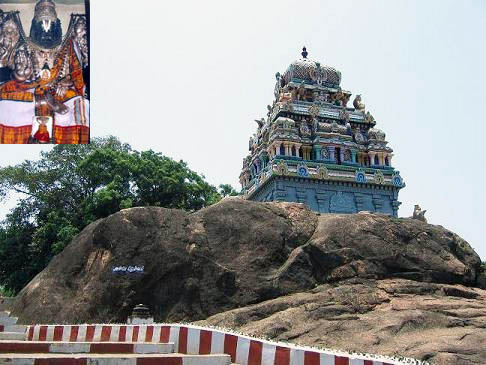Name of the Temple |
|
Location |
- Kancheepuram district, 40 Km away from Chennai, Tamilnadu, India
|
| How to reach there? |
- By Air: The nearest airport is the Chennai Airport, 17 km. From the airport take the National Highway 32 north-east to reach Siṅgaperumāḷ.
- By Train: The nearest railway station is Chennai Central, 4 km north of Siṅgaperumāḷ temple.
- By Road: Chennai is connected by the National Highway 32 from Chennai to Nagapaṭṭinam, 4 from Chennai to Puṇe, 16 from Chennai to Vijayawāḍā and 716 from Ananthpur to Chennai.
|
Rulers/builders and Time Period |
- The 1500 year old temple near Chennai is believed to be one of the several cave temples built by the Pallavas. A rock carving at this temple refers to a donation given to this temple around 500 century AD. Hence, this temple can be said to be at least 1500 years old and can be called as a Purāṇa Sthalam. (Pallava King Mahendra Varma (580-630AD) had built about ten cave temples during his time.)
|
Deity/Deities |
- Pāthaladhri (Ugra) Narasimha Sitting Posture East Facing with Goddess Lakṣhmi in his chest
|
Architecture Style |
- The famous Lord Narasimha Temple is on top of the small hill. The Lord Narasimha (Fourth Avathāra) residing inside a cave in Yoga Posture. The entire temple and the idol was constructed from a single rock of the mountain. This is the specialty of the temple.
- This is a beautiful rock cut temple. The temple and even the deity is carved out of a small hillock. In Sanskrit Pāthala adhri means a reddish hill. The original name of this place itself is Pāthalādhri puram. The main sanctum itself is a rock cut shrine on which the deity too is carved out of the hill itself. So, whoever wants to do circumambulation around the temple has to actually go around the small hillock as Giri Pradhakṣhiṇam. Hence, Giri Pradhakṣhiṇam is very popular here.
- There are Bali Pīṭhams seen at certain directions, while going around the temple. The main deity is seen here as Ugra (fierce) mūrthi, holding Pānchajanya (conch) and Sudharśhana Chakra, showing Abhaya Hastha in one of His hands. Śhrī Narasimha Swāmi here has 3 eyes and the third eye is shown by the priest while performing Ārathi.
- While walking around the temple, there is an Azhinjal tree in this temple, which is considered most sacred. It is said that this tree has mentions in the ‘Nāchiyār Thirumozhi’ composed by Sri Āndāḷ. People praying for marriage or children tie a small piece of thread from their clothes on the branches of this tree. By doing this with a wish, it is believed that their wishes are granted.
- Śhrī Ānjaneyar (Hanumān) is seen on the pillar adjacent to Dwajasthambha, where many people light Ghee lamps for the God. While entering into the street of this temple, there are 4 pillars welcoming us, which look too ancient having beautiful sculptures. The Thīrtham in this temple is called Śhuddha Puṣhkaraṇi and Sthala Vrukṣham is Pārijātham.
|
Other Special Features |
- The temple was surrounded by a big forest where Sage Jābāli was doing penance praying to the Lord to appear before him. The legend has it that at the request of Sage Jābāli, Narasimha, Singaperumāḷ or the Lion God, manifested himself immediately after he packed off Hiranyakakṣhipu to the nether world.
- The Lord even now gives darśhana to the devotees in the same form with four hands, two of them holding Sudarśhana and Pānchajanya and the third in "Abaya Hastha" pose with the fourth pointing towards the earth.
- Found in sitting posture the Lord has three eyes, and wears the Sālagrama and Sahasranāma garlands.
- The Goddess here is known as Ahobilavaḷḷi. According to temple sources, this temple has been referred in Brahmāṇḍa Purāṇam.
|
Any Other/Remarks
|
- Here he proves to the Universe that both Hari and Hara is one and the same and not separate. Here the Lord has a Third Eye, like Rudhramūrthi and every time the temple priests perform the Ārathi or Dīpārādhana, theNāmam of Narasimhaswāmi is lifted up for the devotees to have a darśhana of the Third Eye.
- In the Narasimha Avathāra, Mahaviṣhṇu destroyed evil and it is believed by both the Vaiṣhṇavaites and the Śhaivites that if one gets the darśhana of the Third Eye, all misery in life would be removed.
|
Special Reference to Performing Arts: |
- “Narasimha Āgacchha” is a popular krithi by Muthuswāmi Dikṣhithar in the Rāga mohana on the God Narasimha.
|
Bibliography |
|















